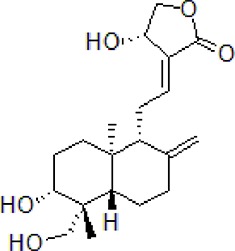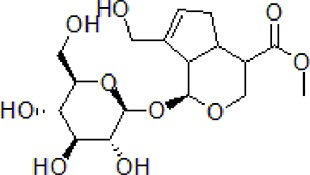Table 3.
TCM for treating AD by inducing or attenuating autophagy effect.
| Numbers | Compounds | Chemistry structure | Dosages | Activities | Molecular mechanism | Models | References |
|---|---|---|---|---|---|---|---|
| 1 | Berberine |

|
50–100 mg/kg/day | Promote Aβ clearance, improve learning and memory capacity | Induce autophagy by activating Bcl2/Beclin1 signaling | 3 × Tg-AD mice | Huang et al., 2017; Zhang et al., 2018 |
| 2 | Andrographolide |

|
20 μM | Decrease cell death | Induce autophagy through activation of the Nrf2-mediated p62 signaling pathway | PC12 cells | Gu et al., 2018 |
| 3 | Geniposide |

|
50 mg/kg/day | Reduce Aβ1–40 level, promote Aβ clearance, improve cognitive function | Induce autophagy by down regulation of mTOR | Age-matched C57BL/6 wild-type (WT) mice or APP/PS1 mice | Shan et al., 2017; Zhang et al., 2019 |
| 4 | β-asarone |

|
240 μg/mL | Increase cell viability, decrease NSE levels | Attenuate autophagy by Akt-mTOR signaling pathway | PC12 cells | Wu and Fang, 2004; Xue et al., 2014 |
| 5 | Dendrobium nobile Lindl. alkaloids | — | 3.5–350 ng/mL | Inhibit axonal degeneration | Induce autophagy by promoting Beclin1 | Aβ25–35-induced hippocampus primary neuron | Li et al., 2017 |
| 6 | Euxanthone | — | 30 mg/kg or 60 mg/kg | Attenuate memory and spatial learning dysfunction | Induce autophagy by increasing the expression level of LC3B-II and enhancing the degradation of p62 | Sprague-Dawley rats | Pan and Mao, 1984; Yuan et al., 2018 |
